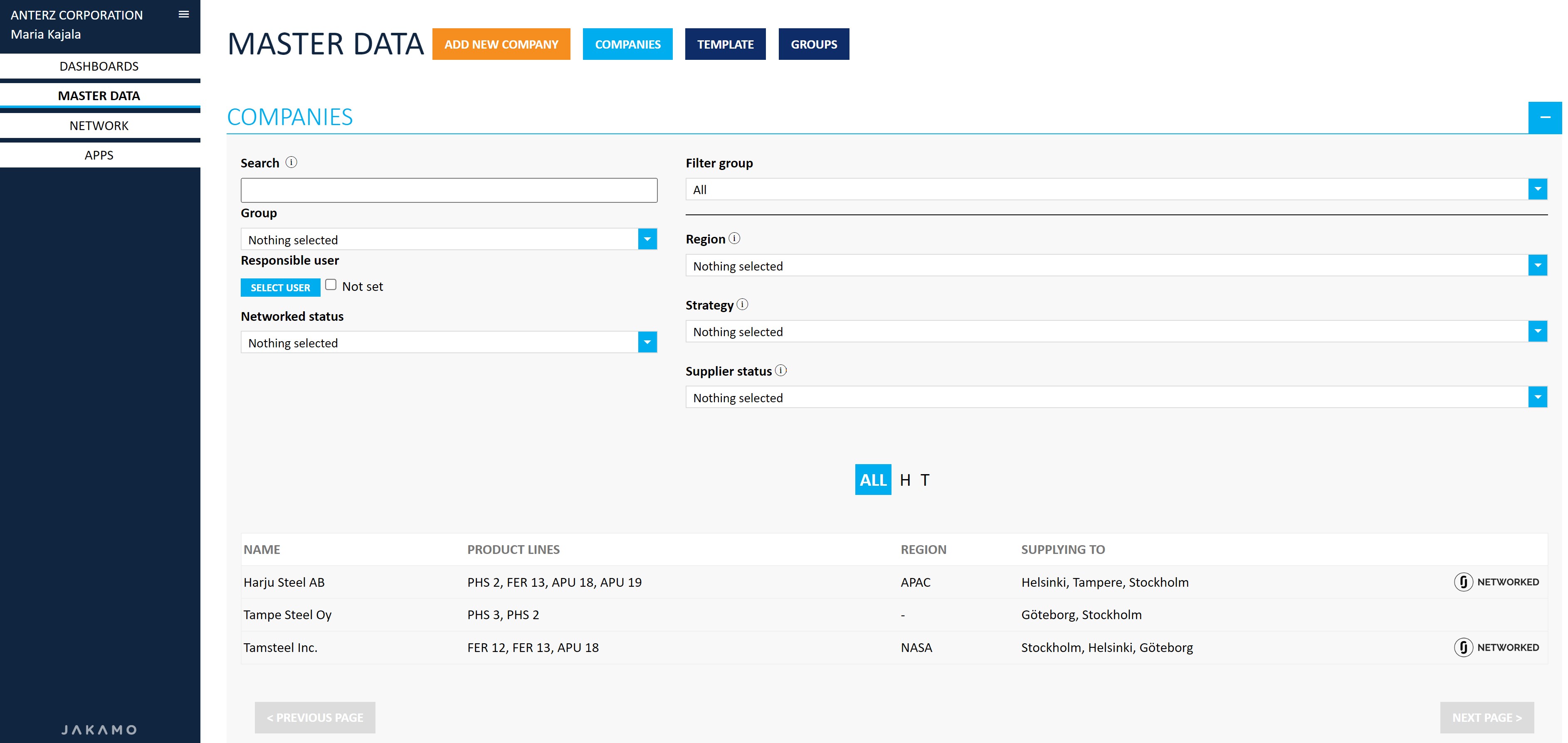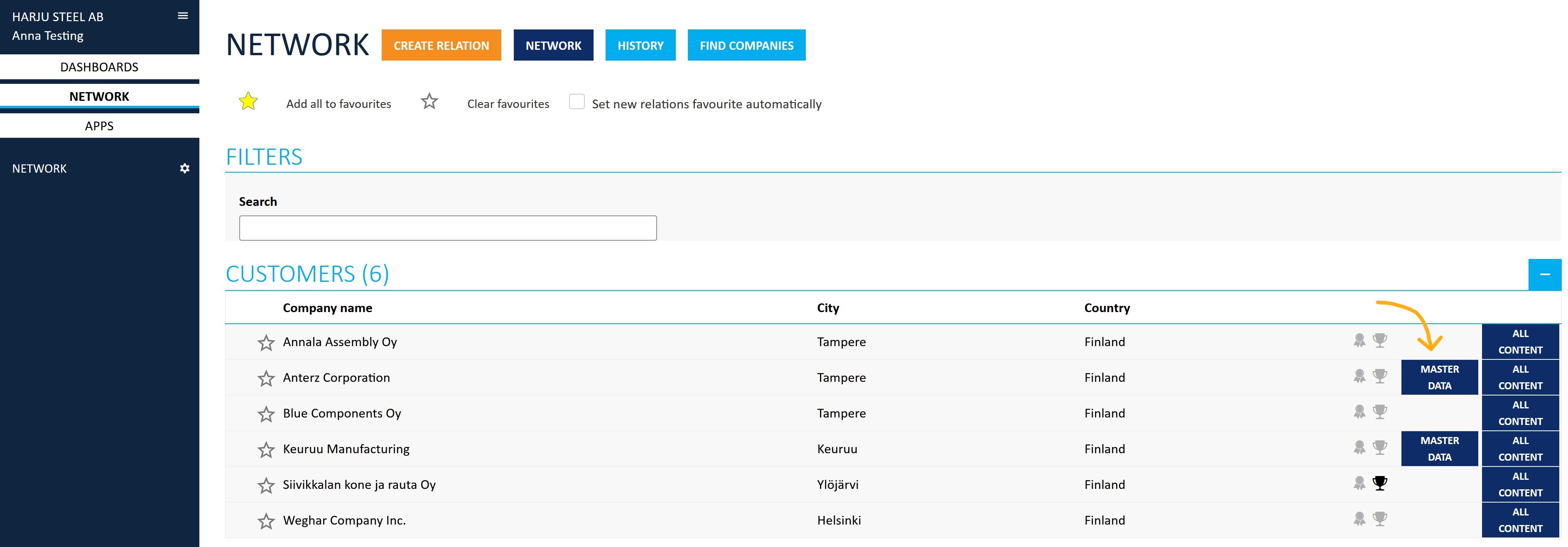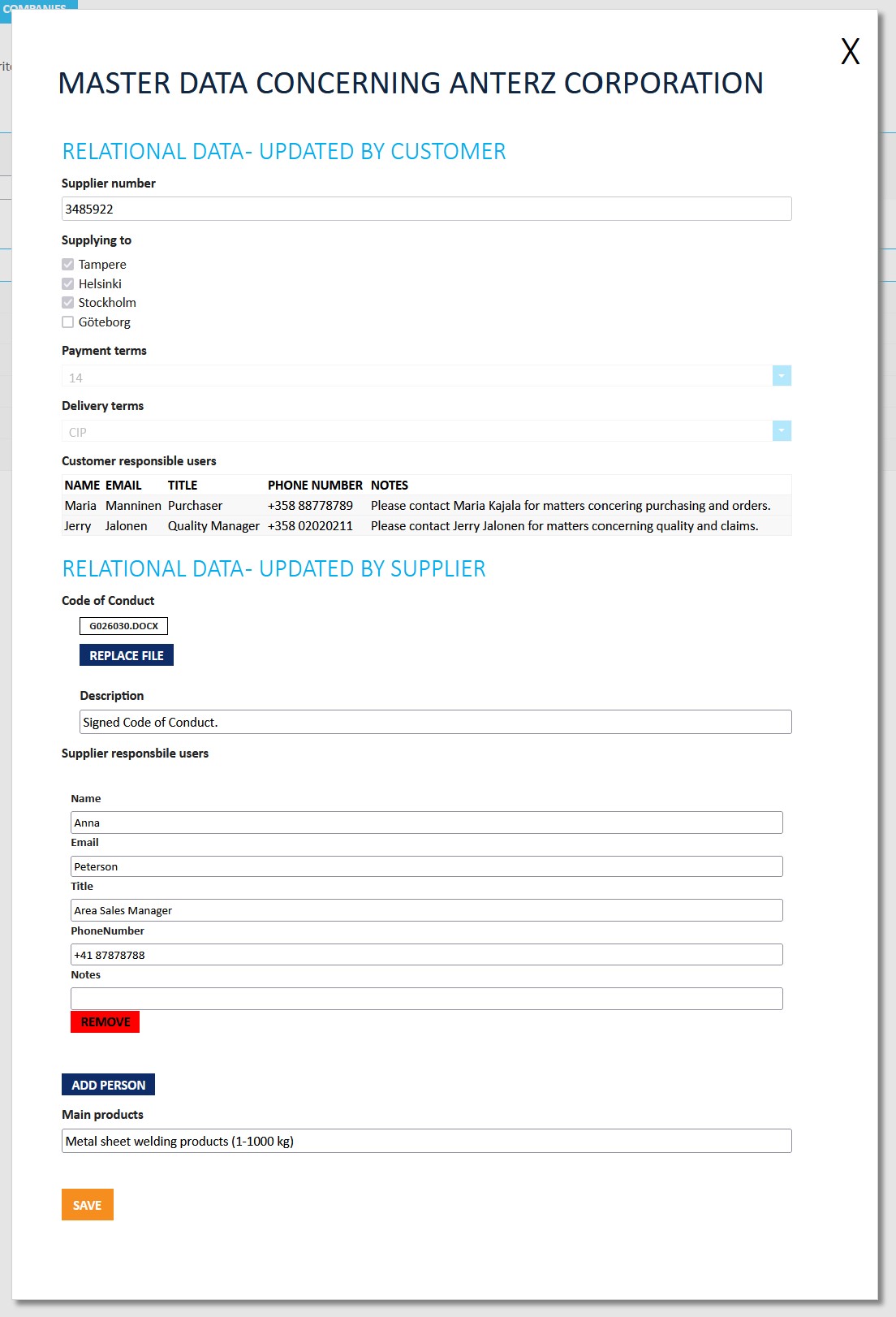Master Data
The Jakamo Master Data module is designed to collect, maintain and share your company's supplier-related information in one dedicated place.
The Jakamo Master Data module is available for your company for an additional cost. If the Master Data module is activated for your company, it is available for you in Jakamo on the left navigation bar on MASTER DATA between Dashboards and Network sections.
You can keep a complete and organized record of your entire supplier base in one place! With Jakamo Master Data, you don't need all your suppliers to be connected in Jakamo to use it. Unlike other Jakamo applications, the Master Data module allows you to manage data for both suppliers who are already connected with you in Jakamo and those who aren't yet.
1. Companies in Master Data
The Master Data module provides a holistic view of your supplier base and individual supplier profiles. You can use default and customizable filters to search and categorize companies in your Master Data. You can also create customized filter groups to make it easier for you to find the information you need.
Each of your suppliers has their own supplier master data profile which includes information about that company. Typically, the supplier information is imported from your database and therefore supplier profiles are created automatically. Another way is to create a new supplier profile manually via the Jakamo user interface.
On the front page of Jakamo Master Data, you'll find an alphabetical list of all your suppliers' profiles:

1.2 Filters
You can search for companies in the database using both default and customizable filters. These filters help you find, narrow down, or categorize companies in your Master Data.
Default filters available
- Search: Find suppliers by their name or other fields included in this search. You can see the available search fields from the
iicon. - Group: Find suppliers belonging to the same group. The group consists of the parent company and its subsidiaries defined and connected by you in
Groups. - Responsible user: Find suppliers based on the Jakamo responsible user you have assigned to a certain supplier.
- Networked status: Find suppliers with whom you have also a relation within Jakamo. If the supplier has a
Networkedtag available in the companies list view, it means that the supplier can see the relational data you have gathered about them on their master data profile.
Customized filters and filter groups
You can create customized filters and filter groups, which will appear on the right side of the filter block on the Jakamo Master Data front page. Learn how to set up these selected filters and filter groups for your users to use in Master Data.
2. Supplier's master data profile
Enter and view the supplier's master data profile by selecting the supplier from the companies list. The supplier profile consists of five different sections:
- Basic info (default)
- Users (default)
- Internal data (customizable)
- Relational data - updated by customer (customizable)
- Relational data - updated by the supplier (customizable)
Data template
We understand that every company has unique supplier-related information needs, so we do not have a default Master Data structure. Instead, you can create your template to define the information fields and types of information you want to collect from your suppliers. The information shown in customizable sections of Master Data is defined in Master Data Template.
2.1 Basic info
The first default section in Jakamo Master Data is Basic Info. This section includes the supplier's name, DUNS number, and Jakamo company linkage if existing. The field Jakamo company shows the Jakamo company connected to the supplier's master data profile. Only customers can view and update the information in the Basic Info section.

2.2 Users
The second default section in Jakamo Master Data is Users. This section is for assigning responsible user or users to preferred suppliers, such as supplier responsible persons or supplier quality engineers. Only users with access to Jakamo can be added as users. Only customers can view and update the information in the Users section.

2.3 Internal data
Information under the Internal data section is available only for customers to see and update the information. Here company can have information about the supplier, but information is not shared with the supplier.
For example, the information can be related to:
- Supplier basic information (name, vendor codes, invoicing details)
- Supplier strategies
- Supplier categorization
- Supplier classification
2.4 Relational data - updated by the customer
Information under the Relational data - updated by customer section is available for both, for customer and supplier, to see, but only for the customer company to update the information.
For example, the information can be related to:
- Supplier basic information (e.g. address information)
- Sites this supplier is supplying to
- Product lines this supplier is supplying to
- Payment terms
- Delivery terms
- Ordered value or ordered amount monthly, annually
For example, the documents shared and collected in relational data can be:
- NDA
- Code of Conduct
- Quality Manual
- Financial statement
- Agreements or contracts (if not shared with supplier in Jakamo’ Contracts application)
- Audit documentation (if not shared with supplier in Jakamo’s Audits application)
See from the Master Data Template instructions how to create static or dynamic document fields.
2.5 Relational data - updated by the supplier
Information under the Relational data - updated by supplier section is available for both, customers and suppliers, to see and update the information.
For example, the information can be related to:
- Supplier's contact person information
- Supplier site or headquartered information
- Information on supplier's products
- Information on supplier's manufacturing technologies
- Certificates or documents required from the supplier (ISO certificates, code of conduct, conflict mineral declaration, environmental assessments)
For example, the documents shared and collected in relational data can be:
- Certificates (e.g. ISO14001, ISO9001, ISO18001)
- Signed Code of Conduct
- Supplier’s Code of Conduct to customer
- Conflict Minerals Declaration
- Supplier’s environment policy, safety policy, equality (DEI) policy
- Supplier’s carbon footprint reports (or other GHG reports and calculations)
- Action plan to reduce the carbon footprint and other sustainability effects
See from the Master Data Template instructions how to create static or dynamic document fields.
3. How can a Supplier find and fill in Master Data?
The Jakamo Master Data module is designed to collect, maintain and share your company's supplier-related information in one dedicated place.
The supplier can view their master data profile and the information in the relational data sections you have shared with them in Jakamo. If you have connected your Jakamo relation with that supplier with your master data profile you have for that specific supplier, the supplier is Networked and therefore able to see the data you have available.
Suppliers can see if they have a master data profile available on any of their customers from their Jakamo account navigation bar NETWORK.

Suppliers can see all the data you have in Relational data - updated by customer and in Relational data - updated by supplier. The supplier can update the information you have in Relational data - updated by supplier.

4. Template
The template is a functionality to build a structure for the company's supplier master data. Template structure defines the information fields and types of what kind of information is possible to add to certain fields. The template is a basis for each supplier profile and it guarantees that the profiles contain consistent information. See detailed instructions for establishing a template here.
Jakamo does not have any default Master Data structure. Once the Master Data module is activated, there will be no content in it. The company has to define which kind of information it wanted to have in its Master Data and create a template according to the needs. This means that customers can freely customize the information they collect from their suppliers and what information is available also to partner companies.
5. Add new company
Typically, a new supplier profile is created with mass import from your database to Jakamo in the Jakamo rollout phase. Another way is to create a new supplier profile manually via the Jakamo user interface.
Create a new master data profile manually from the Master Data front page with the ADD NEW COMPANY functionality. The new master data profile opens with a pre-defined template made by you. Fill the template with the supplier information and save the profile by using the orange SAVE button on some of the sections.
Define and create preferred template to your Jakamo Master Data before adding any new companies to your Master Data. Without a template, you are not able to add any information despite the Basic info and User information.
6. Supplier-related information from external systems
With Jakamo Master Data, you can manage your supplier-base-related information and even enrich it with supplier-related data from external systems. We allow embedded BI reports or risk analysis information to be shown on the supplier's master data profile.
Many different external systems are already integrated into Jakamo Master Data. If you want to know more about integrations from external systems to collect supplier-related data and to show and share information in Jakamo Master Data, please contact Jakamo support.
Didn't you find what you were looking for? Send an email to Jakamo support (support@thejakamo.com) and we will help you.